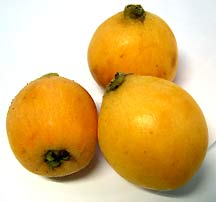|
Key Ingredient
|
Loquat
Delicious fruit is
available for short time
 |
The basics: Loquat, called biwa in Japan or pipa in China, is the fruit of an evergreen tree indigenous to southeastern China. It was introduced to Japan more than 1,000 years ago and became established there, too. Today, Japan is the leading producer of loquats.
Loquat trees have been in the islands for many years, but have remained a backyard crop until recently. Clark Hashimoto in Kula, Maui, and another grower on the Big Island have trees that are producing good crops. Hashimoto's trees are believed to be more than 50 years old and were probably brought to Hawaii from Japan by his grandfather. His fruit are large, juicy and sweet, yet slightly tart.
Loquats resemble figs and are said to be like apricots in texture, although much juicier. A slightly fuzzy, orange skin covers the fruit and should be pulled off before eating. The fruits' several large seeds should not be consumed; they can be poisonous in large quantities. Be careful not to crack them when eating the fruit.
Selecting: Loquats bruise very easily, so they are generally unavailable outside the locations where they are grown. Loquats available here are large, meaty and juicy. Look for fruit that is deep orange and firm to the touch.
Storing: Fruit should be stored in the refrigerator will last for a week or so. Some brown spots and bruising may occur in storage.
Use: The skin needs to be removed before consuming. Dunking loquats in boiling water for a few seconds should make it easier to pull the skin off. Fresh loquats are a rare treat, but loquats can also be made into jellies, incorporated in sauces or made into sorbets.
Where to buy: Loquats are available for a limited time at the Saturday Farmers' Market at Kapiolani Community College and the new Mililani Farmers' Market. Weather permitting, they should be available through April. Prices run $5.25 for 1-1/2 pounds.
![]()
a free-lance food writer. Contact her
online through features@starbulletin.com
[News] [Business] [Features] [Sports] [Editorial] [Do It Electric!]
[Classified Ads] [Search] [Subscribe] [Info] [Letter to Editor]
[Feedback]
